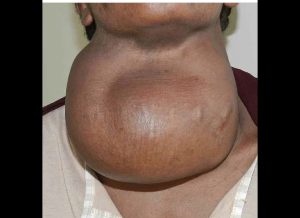
A goiter, is a swelling in the neck resulting from an enlarged thyroid gland.
Goiter can have various causes, including:
1. Iodine deficiency: A lack of iodine in the diet can lead to goiter.
Iodine is required for the production of thyroid hormones, and when levels are low, the thyroid gland may enlarge in an attempt to compensate.
2. Hashimoto’s thyroiditis: This is an autoimmune condition where the body’s immune system attacks the thyroid gland, resulting in inflammation and goiter.
3. Graves’ disease: Another autoimmune disorder, Graves’ disease, causes the thyroid gland to produce excess thyroid hormones, resulting in goiter.
4. Thyroid nodules: The presence of nodules or growths on the thyroid gland can lead to enlargement.
While goiter itself may not cause symptoms, some people may experience symptoms like:
– Swelling or visible enlargement of the neck
– A feeling of tightness or discomfort in the throat
– Hoarseness or voice changes
– Difficulty swallowing or breathing
It can be associated with a thyroid that is not functioning properly.
Worldwide, over 90% of goiter cases are caused by iodine deficiency.
A goiter can present as a palpable or visible enlargement of the thyroid gland at the base of the neck.
A goiter if associated with hypothyroidism or hyperthyroidism, may be present with symptoms of the underlying disorder.
For hyperthyroidism, the most common symptoms are tachycardia, palpitations, nervousness, tremor, increased blood pressure and heat intolerance.
Clinical manifestations of hyperthyroidism are often related to hypermetabolism, excessive thyroid hormone, an increase in oxygen consumption, metabolic changes in protein metabolism, immunologic stimulation of diffuse goitre, and ocular changes of exophthalmos.
Hypothyroidism associated with poor appetite, cold intolerance, constipation, lethargy and may undergo weight gain.
WHO classification of goiter by palpation, the severity of goitre is currently graded as grade 0, grade 1, grade 2.
Worldwide, the most common cause for goiter is iodine deficiency, commonly seen in countries that scarcely use iodized salt.
Selenium deficiency is also considered a contributing factor.
In countries that use iodized salt, Hashimoto’s thyroiditis is the most common cause.
Goiter can result from cyanide poisoning, which is particularly common in tropical countries where people eat the cyanide-rich cassava.
A goiter may be classified either as nodular or diffuse.
Nodular goiters are either of one nodule or of multiple nodules.
Multinodular goiter (MNG) is the most common disorder of the thyroid gland.
Uninodular goiter: one thyroid nodule; can be either inactive, or active – autonomously producing thyroid hormone.
Multinodular goitre: multiple nodules;can likewise be inactive or toxic, the latter is called toxic multinodular goitre and associated with hyperthyroidism.
Inactive nodules in the same goitre can be malignant.
Thyroid cancer is identified in 13.7% of the patients operated for multinodular goite.
Diffuse goiter refers to when the whole thyroid appears to be enlarged due to hyperplasia.
Class I: the goiter in normal posture of the head cannot be seen; it is only found by palpation.
Class II: the goiter is palpable and can be easily seen.
Class III: the goitre is very large and is retrosternal.
Treatment:
Goiter is treated according to the underlying cause.
If the thyroid gland is producing an excess of thyroid hormones (T3 and T4), radioactive iodine is given to the patient to shrink the gland.
If the goiter is caused by iodine deficiency, small doses of iodide in the form of Lugol’s iodine or KI solution are given.
If the goiter is associated with an underactive thyroid, thyroid supplements are used as treatment.
Sometimes a partial or complete thyroidectomy is required.
Goiter is more common among women.
Before iodine enrichment programs, goiters was common in areas with repeated flooding or glacial activities, which erodes the topsoil.
Goiter is endemic in populations where the intake of iodine is less than 10 µg per day.
